There are just about as many opinions for pruning almond trees as there are almond growers.
As with pruning trees in general, some experts advise extensive pruning to stimulate growth, while others recommend clipping just a few branches here and there.
Still others advocate for throwing your shears away entirely, and doing away with pruning altogether.
All of this contradictory advice is enough to drive a person nuts (no pun intended). The truth is, the best way to prune an almond tree all depends on who’s doing it.
What it really comes down to is what you value most, and what your reasons are for trimming them in the first place.
This may be a combination of things, including appearance, production goals, and tree health.
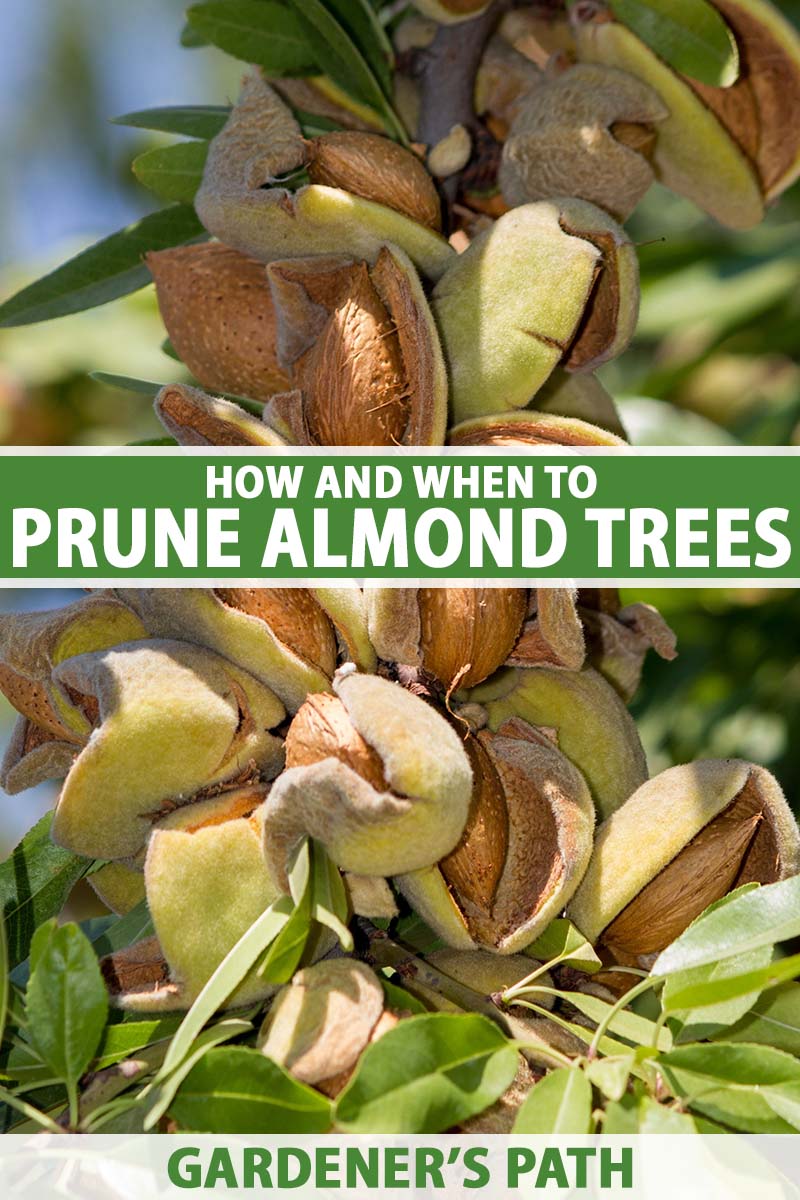
We link to vendors to help you find relevant products. If you buy from one of our links, we may earn a commission.
In commercial farming, the answer to this question regarding the goal of pruning is almost always,“for high yields.”
This can sometimes mean using techniques that produce highly productive trees that are less healthy in the long run.
Meanwhile, backyard homesteaders may be less concerned with high yields and more focused on growing healthy trees, or ones that produce higher quality nuts.
Whatever your reason for pruning, the general consensus is that occasional trimming is needed to keep them happy, healthy, and productive.
How should you go about this, and when is the best time to prune?
We’ll explore this and more in this article. Here’s a quick preview of what’s ahead:
What You’ll Learn
Pruning When the Time is Right
It’s commonly thought that fruit trees should be pruned every year – so you might assume this would also be the case for almonds.
However, almonds are sensitive and they don’t take too kindly to regular intensive pruning.
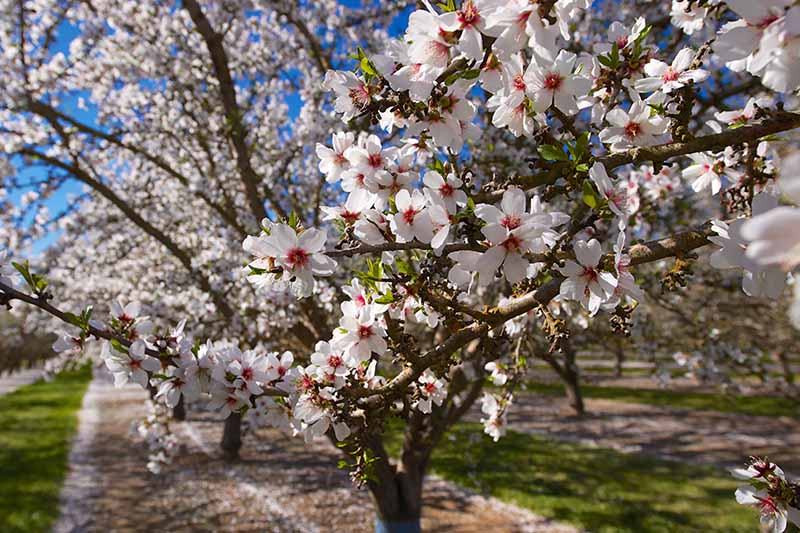
Although you’ll want to remove crisscrossing branches as well as dead or diseased branches every year, annual intensive pruning is not necessary.
Pruning needs also tend to vary with age. Let’s take a closer look at the best strategies for younger and older almond trees.
Young Trees
Some grower trials indicate that early pruning of younger specimens can make for healthier plants that produce higher yields over the life of the tree.
Unpruned young almond trees produce branches that have a tendency to split over time, ultimately weakening the plant and leading to crop loss.
For this reason, some structuring of first- and second-year trees is recommended to help prevent branches from weakening later in life.
Pruning young almond trees usually follows a plan similar to this:
First Year
An initial trim is recommended when you first plant your sapling. Usually, you’ll be planting a nursery-grown rootstock that will be about one year old when it arrives at your door, or when you bring it home.
Cut one-year-old dwarf types back when you transplant them, to around 36 inches above ground level. Dwarf types are those that will reach up to 10 feet in height at maturity.
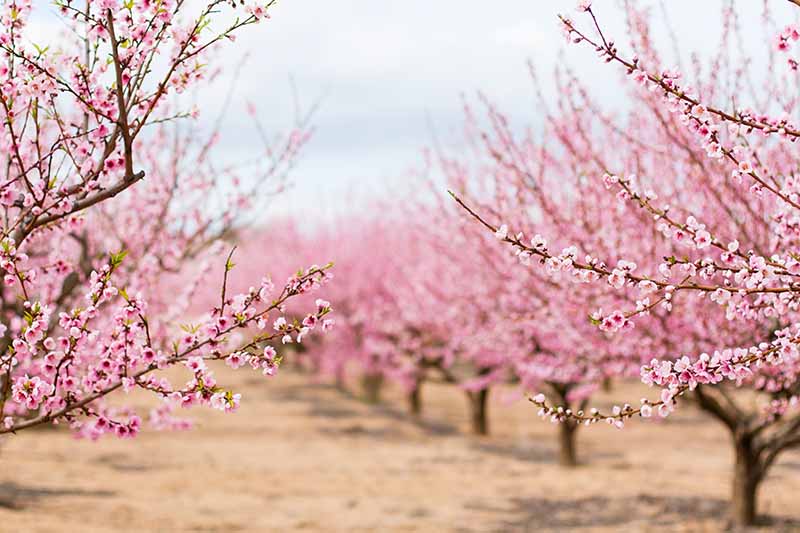
Trees in the range of 15 to 30 feet, or semi-dwarf to standard specimens, should be cut back to 42 to 48 inches above ground.
This is followed by pruning for the first time. Pruning should always be done during a tree’s dormant period.
The first time that you prune will determine the ultimate shape and performance of the tree in large part, so it’s important to get it right.
First, select three to four permanent primary “scaffolds,” or main limbs that will go on to form the main structure of your tree throughout its life.
These scaffolds should grow at an upward angle of around 45 to 60 degrees from the base, or trunk. They should be spaced out three-dimensionally around the tree to allow light to enter the top of the canopy.
Once these primary scaffolds are selected, all other limbs that originate from the trunk should be removed, as well as all growth below the lowest primary limb.
Leaving more than three to four branches in place can be detrimental to your tree later in its life, weakening its structure, preventing good air circulation, and limiting light penetration.
Second Year
Pruning should be repeated when the tree is dormant in its second year.
By this point, it will likely have produced several lateral branches. It’s best to leave two per branch, which will become “secondary scaffolds.”
Apart from this, you can also remove any shoots or branches that are growing up through the center that might block air and light penetration.
Remove narrow-angled secondary branches as well when pruning your second-year trees.
Prudent Pruning Later in Life
Pruning will become progressively less intensive as your almond tree grows. Once the primary prunings are done, to give it its long-term structure, trimming is much less intensive and focuses more on general maintenance.
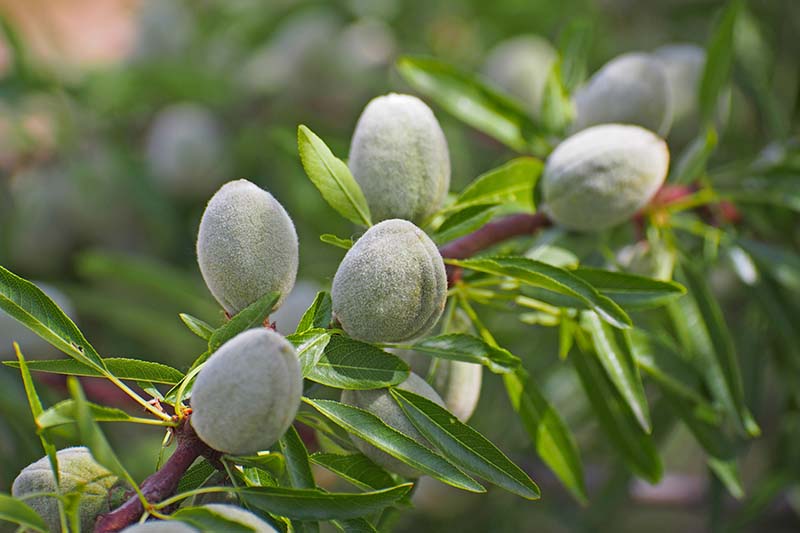
This includes removing dead, broken, or diseased branches. These might compromise the whole tree by allowing disease to spread in the case of diseased branches, or by attracting new fungal diseases or insect pests in the case of deadwood.
Removal also helps with regeneration by allowing the tree to heal over wounds that would otherwise be blocked by dead branch matter, which can allow pests and disease pathogens to become established.
Sprucing up the shape can be done here and there as well.
This may include removing branches that are growing into the center of the tree, clipping crisscrossing branches that are growing into one another by choosing the best one to keep, or cutting branches that are growing towards the ground or directly upward.

By the fifth year, which is typically when most start to produce almonds, you’re on the home stretch. Pruning should be kept to a minimum, with just a little maintenance done here and there.
If all goes well, your tree will reach maximum production of 50 to 65 pounds of nuts in around 12 years, and continue producing for up to 30 years.
General Pruning Advice to Note
There are two types of cuts to keep in mind when you work: heading cuts and thinning cuts. Heading cuts refer to those which remove only part of an existing branch, while thinning cuts refer to removing the entire limb.
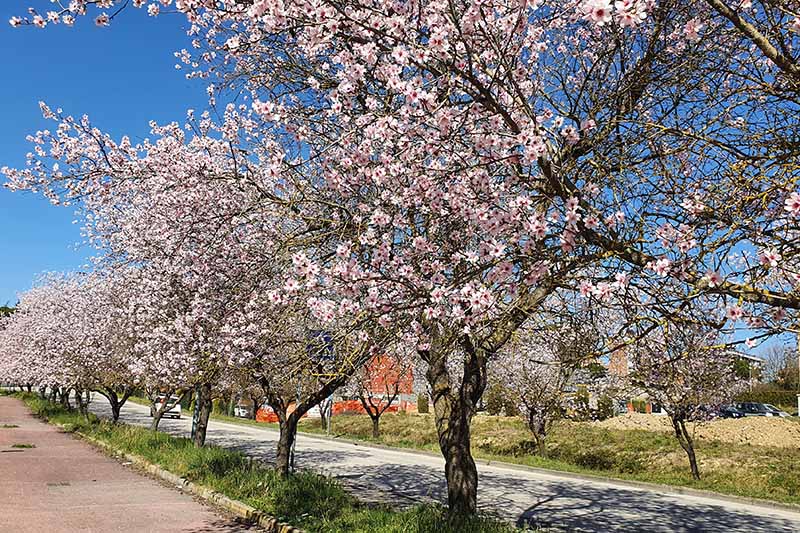
Prune a couple of inches above buds when doing heading cuts.
Almonds and other trees tend to die back a bit out from the cut, so if you cut directly at the bud you’ve selected as the next section of ideal growth on a branch, that bud will likely die, and another bud that may be growing in the wrong direction will grow.
Remember to cut to the branch collar only, or the shoulder between a branch and the trunk, rather than making your cuts flush with the trunk.
This can help to prevent rot and infection, whereas making your cuts too close can invite problems and weaken your trees.
Every time you cut a branch, this opens up a wound that is susceptible to disease. This is particularly pertinent in the case of almonds, which are especially sensitive.
If you’re buying a new tree, always choose disease resistant varieties to mitigate this danger.
‘Texas Mission’ is available from Nature Hills Nursery in #3 containers. Very popular among commercial growers, this variety is noted for its disease resistance.
It’s also best to prune only when the weather is dry and there is no chance of rain in the forecast. Damp conditions are perfect for fungal spores to infiltrate and gain a foothold.
This is especially important with young, developing trees.
Pruning should only be done with sterile tools to help prevent the spread of infection. Sanitize your tools before you start with a solution of 10 percent rubbing alcohol and water, and clean them again between plants or between diseased branches.
Top Tips for Pro Pruners
- Always remove dead and diseased branches first.
- Prune for air circulation: you may want to cut some branches from the center to facilitate better air circulation and prevent fungal diseases.
- Prune for light penetration, which will facilitate fruit ripening. But use caution: if you remove too many branches, you can actually let too much light in, which can scald the inner trunk in the hot sun.
- Focus on the main trunk and larger branches, and work outward instead of from the outer branch tips working inward. This saves time, preventing unnecessary cuts, and keeps your attention on the main structure.
- Prune branches that are crossing each other, removing the one that’s growing inward, or at an inappropriate angle.
- Cut to the branch collar only, rather than all the way to the trunk.
- Work only with clean, sanitized tools, and clean between cuts when removing diseased wood.
A Little Early-Life Nurturing Makes All the Difference
The first time you prune your young tree will set it up for success or failure. Choose your scaffolds carefully, take time to plan your cuts, use sharp and clean equipment, and don’t get carried away, and you’ll do great.
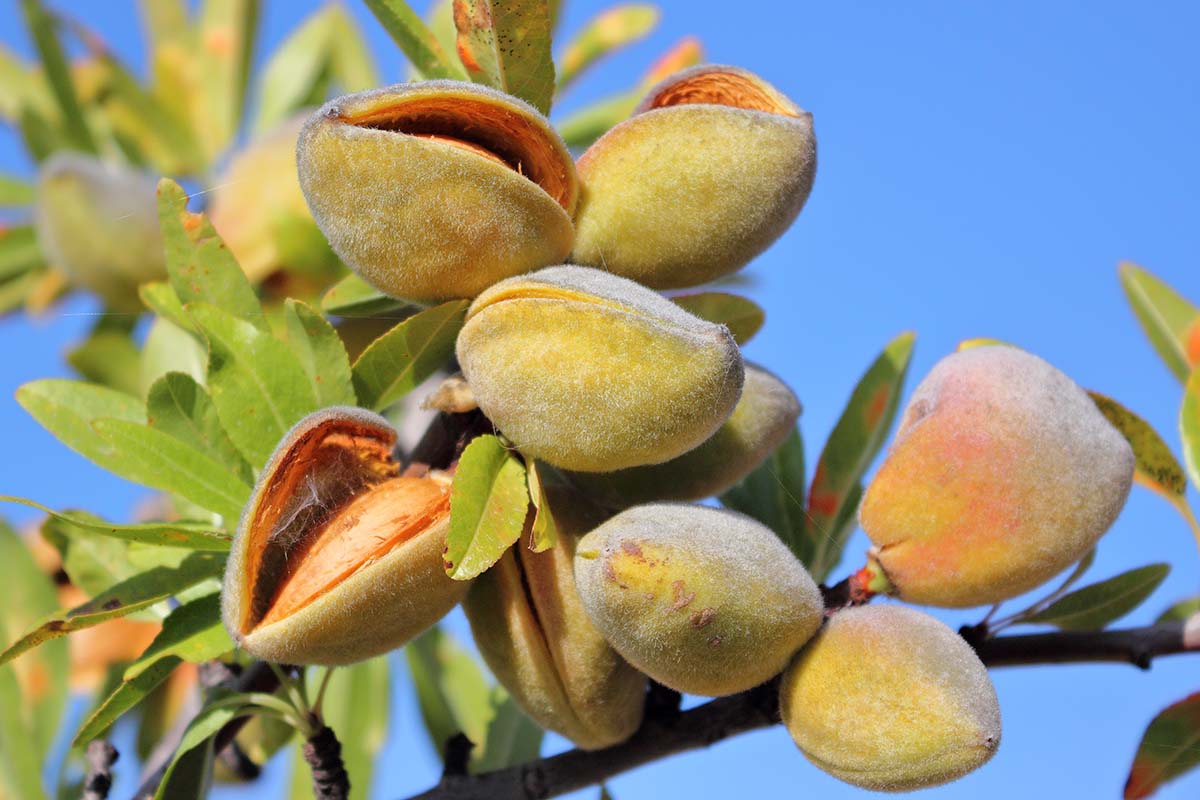
After the initial two years of pruning, resist the urge to intensively prune as you would most fruit and nut trees, and you’ll be enjoying harvests of delicious almonds for years to come!
Have you had any luck (or lack thereof) with pruning almond trees? What tips and tricks have worked for you? Please share your own successes, failures, and questions in the comments section below.
And if you found this guide valuable, you’ll also enjoy these other articles about growing and maintaining nut trees:
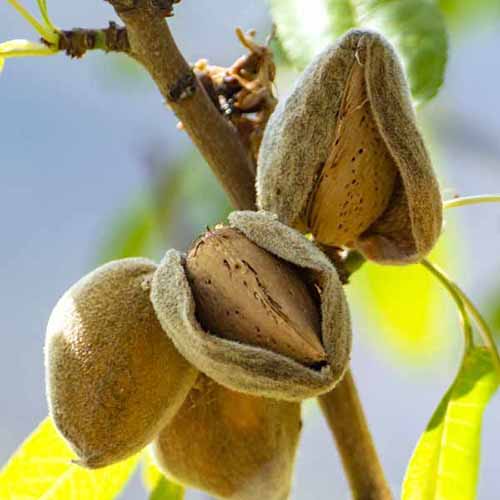
I think the explanation was complete and logical
Each season a grub forms inside of most of our almond’s nuts. We have a dwarf almond. Can you give any tips on how we can prevent this from happening please?
Hi Linda, what region are you in? On the west coast, the navel orangeworm is extremely common. The adults, which are brownish-gray moths, lay eggs on the husk and the larvae tunnel their way into the center and eat the nutmeat. Less often, nut weevils (Curculio nucum) will tunnel into the center of the husk. Both are cream with brown heads. For navel orangeworms, always be sure to remove all the nuts from the tree in the fall and clean up any on the ground. Spray the tree with a product containing Bacillus thuringiensis as soon as the nuts start… Read more »
I came too late to this great article on pruning and now my tree is wild and unruly. It is about 4 years and has produced for 2 years, last year best and this year not many. I would like to do major cuts on most areas, will do it in dormant dry season. How will this affect production? And where do almonds develop best, on new branches…or?
Are you growing a self-pollinating variety? Growing at least two almonds is typically required to produce a harvest. Pruning gradually over the course of a few years to correct and maintain an almond’s structure is best, in addition to annual maintenance pruning, rather than pruning heavily in a single year. You want to be careful to avoid removing so much growth that you shock the plant. Overall, nut production will be impacted when removing new wood, but almonds are produced somewhat cyclically, and the majority of new growth in young trees is vegetative rather than fruit-bearing. Fruit-bearing spurs often produce… Read more »
Hi, I have a Caribbean Almond Tree that was pruned this past week. I am wondering whether the gardener did it correctly or not? I am attaching a Before and After photo. He said this cutting will help it to prosper.
Thank you for your feedback! And the Caribbean Almond Tree is located in the Caribbean.
I started him as a small plant and would like him to prosper!
Hi there! It looks like your plant was pruned well. I might have tried to even the growth out a little all the way around, but you can do that yourself by pinching back or trimming back some of the longer branches to make it more even. Just wait a few months before you do that, though, since your plant was just pruned.
It’s healthy to open up the trunk and define the whorls of branches like the pruner has done here.
If you do regular pruning to maintain the shape you won’t need such dramatic trimming in the future.
Hello,
I am in northern France ( zone 7b). I have a 2metre tall almond tree, at least 5 years old (was roughly the same size when purchased bare root from local nursery) that was damaged at the time of original transplanting so only one major branch on one side flowers. Should I try clipping the stumps of other branches to see if that will stimulate new growth and balance the tree out? Or are they likely dead forever? And will trimming that good branch help to drive growth elsewhere?
Each year I am getting 1-4 nuts!
Thanks